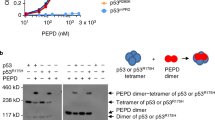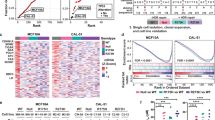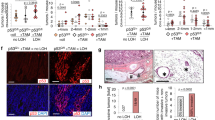Abstract
Since highly expressed human p53 can inhibit human and yeast cell growth, we predicted that p53 mutants could be generated with increased growth inhibition of the yeast Saccharomyces cerevisiae and that these would be useful for characterizing p53 functions and tumor p53 mutants. A random mutagenesis screen led to the isolation of mutations in the DNA binding domain that result in p53 being lethal even at moderate expression levels in yeast. Three independent mutants had an alanine change at the evolutionary invariant V122 in the L1 loop. The other toxic mutations affected codons 277 (C277R, C277W) and 279 (G279R). This latter amino acid change was also reported in tumors, while all the other mutations are novel. A recently developed rheostatable GALI promoter system that provides graded increases in expression of p53 was used to examine the transactivation function of the toxic mutations when expression was greatly reduced and cells were viable. At low expression levels the toxic mutants lacked transactivation from a 3xRGC responsive element (RE). Surprisingly some exhibited enhanced transactivation with p21 and bax REs. The V122A mutant was able to re-activate transactivation of various p53 tumor mutants and retained growth inhibition when co-expressed with dominant-negative tumor mutations. Upon expression in human Saos-2 cells the V122A p53 mutant caused growth suppression, was capable of transactivation and exhibited higher than wild type activity with the bax promoter in luciferase assays. A non-functional p53 tumor mutant was partially reactivated by V122A for both transactivation and growth suppression. Thus, the screen for toxic p53 mutants in yeast can identify novel p53 variants that may be useful in dissecting p53 regulated cellular responses and in developing p53-based cancer therapies.
This is a preview of subscription content, access via your institution
Access options
Subscribe to this journal
Receive 50 print issues and online access
$259.00 per year
only $5.18 per issue
Buy this article
- Purchase on Springer Link
- Instant access to full article PDF
Prices may be subject to local taxes which are calculated during checkout






Similar content being viewed by others
References
Ashcroft M, Vousden KH . 1999 Oncogene 18: 7637–7643
Aurelio ON, Kong XT, Gupta S, Stanbridge EJ . 2000 Mol. Cell. Biol. 20: 770–778
Baker SJ, Markowitz S, Fearon ER, Willson JK, Vogelstein B . 1990 Science 249: 912–915
Bischoff JR, Casso D, Beach D . 1992 Mol. Cell. Biol. 12: 1405–1411
Brachmann RK, Vidal M, Boeke JD . 1996 Proc. Natl. Acad. Sci. USA 93: 4091–4095
Brachmann RK, Yu K, Eby Y, Pavletich NP, Boeke JD . 1998 EMBO J. 17: 1847–1859
Chappuis PO, Estreicher A, Dieterich B, Bonnefoi H, Otter M, Sappino AP, Iggo R . 1999 Int. J. Cancer 84: 587–593
Chene P . 1999 Biochem. Biophys. Re. Commun. 263: 1–5
Cho Y, Gorina S, Jeffrey PD, Pavletich NP . 1994 Science 265: 346–355
Clayman GL, el-Naggar AK, Lippman SM, Henderson YC, Frederick M, Merritt JA, Zumstein LA, Timmons TM, Liu TJ, Ginsberg L, Roth JA, Hong WK, Bruso P, Goepfert H . 1998 J. Clin. Oncol. 16: 2221–2232
Cortes U, Moyret-Lalle C, Falette N, Duriez C, Ghissassi FE, Barnas C, Morel AP, Hainaut P, Magaud JP, Puisieux A . 2000 Mol. Carcinog. 27: 57–64
el-Deiry WS . 1998 Semin. Cancer Biol. 8: 345–357
el-Deiry WS, Kern SE, Pietenpol JA, Kinzler KW, Vogelstein B . 1992 Nat. Genet. 1: 45–49
Flaman JM, Frebourg T, Moreau V, Charbonnier F, Martin C, Chappuis P, Sappino AP, Limacher IM, Bron L, Benhattar J. et al . 1995 Proc. Natl. Acad. Sci. USA 92: 3963–3967
Flaman JM, Robert V, Lenglet S, Moreau V, Iggo R, Frebourg T . 1998 Oncogene 16: 1369–1372
Foster BA, Coffey HA, Morin MJ, Rastinejad F . 1999 Science 286: 2507–2510
Frazier MW, He X, Wang J, Gu Z, Cleveland JL, Zambetti GP . 1998 Mol. Cell. Biol 18: 3735–3743
Freeman J, Schmidt S, Scharer E, Iggo R . 1994 EMBO J. 13: 5393–5400
Gagnebin J, Kovar H, Kajava AV, Estreicher A, Jug G, Monnier P, Iggo R . 1998 Oncogene 16: 685–690
Gallagher WM, Brown R . 1999 Ann. Oncol. 10: 139–150
Giaccia AJ, Kastan MB . 1998 Genes Dev. 12: 2973–2983
Greenblatt MS, Bennett WP, Hollstein M, Harris CC . 1994 Cancer Res. 54: 4855–4878
Guardavaccaro D, Corrente G, Covone F, Micheli L, D'Agnano I, Starace G, Caruso M, Tirone F . 2000 Mol. Cell. Biol. 20: 1797–1815
Hermeking H, Lengauer C, Polyak K, He TC, Zhang L, Thiagalingam S, Kinzler KW, Vogelstein B . 1997 Mol. Cell. 1: 3–11
Hernandez-Boussard T, Rodriguez-Tome P, Montesano R, Hainaut P . 1999 Hum. Mutat. 14: 1–8
Inga A, Cresta S, Monti P, Aprile A, Scott G, Abbondandolo A, Iggo R, Fronza G . 1997a Carcinogenesis 18: 2019–2021
Inga A, Iannone R, Monti P, Molina F, Bolognesi M, Abbondandolo A, Iggo R, Fronza G . 1997b Oncogene 14: 1307–1313
Inga A, Monti P, Fronza G, Darden T, Resnick MA . 2001 Oncogene 20: 501–513
Ishioka C, Englert C, Winge P, Yan Y.X, Engelstein M, Friend SH . 1995 Oncogene 10: 1485–1492
Kern SE, Pitenpol JA, Thiagalingam S, Seymour A, Kinzler KW, Vogelstein B . 1992 Science 256: 827–830
Ko LJ, Prives C . 1996 Genes Dev. 10: 1054–1072
Komarov PG, Komarova EA, Kondratov RV. Christov-Tselkov K, Coon JS, Chernov MV, Gudkov AV . 1999 Science 285: 1733–1737
Lin J, Teresky AK, Levine AJ . 1995 Oncogene 10: 2387–2390
Lin-Goerke JL, Robbins DJ, Burczak JD . 1997 Biotechniques 23: 409–412
Ludwig RL, Bates S, Vousden KH . 1996 Mol. Cell. Biol. 16: 4952–4960
McLure KG, Lee PW . 1998 EMBO J. 17: 3342–3350.
Meek DW . 1998 Int. J. Radiat. Biol. 74: 729–737
Nigro JM, Sikorski R, Reed SI, Vogelstein B . 1992 Mol. Cell. Biol. 12: 1357–1365
Oda K, Arakawa H, Tanaka T, Matsuda K, Tanikawa C, Mori T, Nishimori H, Tamai K, Tokino T, Nakamura Y, Taya Y . 2000 Cell 102: 849–862
Ohki R, Nemoto J, Murasawa H, Oda E, Inazawa J, Tanaka N, Taniguchi T . 2000 J. Biol. Chem. 275: 22627–22630
Oren M . 1999 J. Biol. Chem. 274: 36031–36034
Prives C, Hall PA . 1999 J. Pathol. 187: 112–126
Resnick-Silverman L, St. Clair S, Maurer M, Zhao K, Manfredi JJ . 1998 Genes Dev. 12: 2102–2107
Robert V, Michel P, Flaman JM, Chiron A, Martin C, Charbonnier F, Paillot B, Frebourg T . 2000 Carcinogenesis 21: 563–565
Rolley N, Butcher S, Milner J . 1995 Oncogene 11: 763–770
Saller E, Tom E, Brunori M, Otter M, Estreicher A, Mack DH, Iggo R . 1999 EMBO J. 18: 4424–4437
Scharer E, Iggo R . 1992 Nucleic Acids Res. 20: 1539–1545
Selivanova G, Ryabchenko L, Jansson E, Iotsova V, Wiman KG . 1999 Mol. Cell. Biol. 19: 3395–3402
Sherr CJ . 1998 Genes Dev. 12: 2984–2991
Soussi T, May P . 1996 J. Mol. Biol. 260: 623–537
Swisher SG, Roth JA, Nemunaitis J, Lawrence DD, Kemp BL, Carrasco CH, Connors DG et al . 1999 J. Natl. Cancer Inst. 91: 763–771
Tanaka H, Arakawa H, Yamaguchi T, Shiraishi K, Fukuda S, Matsui K, Takei Y, Nakamura Y . 2000 Nature 404: 42–49
Thornborrow EC, Manfredi JJ . 1999 J. Biol. Chem. 274: 33747–33756
Thukral SK, Lu Y, Blain GC, Harvey TS, Jacobsen VL . 1995 Mol. Cell. Biol. 15: 5196–5202
Velasco-Miguel S, Buckbinder L, Jean P, Gelbert L, Talbott, Laidlaw J, Seizinger B, Kley N . 1999 Oncogene 18: 127–137
Vinyals A, Peinado MA, Gonzalex-Garrigues M, Monzo M, Bonfil RD, Fabra A . 1999 Gene Ther. 6: 22–33
Walker DR, Bond JP, Tarone RE, Harris CC, Makalowski W, Boguski MS, Greenblatt MS . 1999 Oncogene 18: 211–218
Wang Y, Prives C . 1995 Nature 376: 88–91
Wieczorek AM, Waterman JL, Waterman MJ, Halazonetis TD . 1996 Nat. Med. 2: 1143–1146
Wolf JK, Mills GB, Bazzet L, Bast Jr. RC, Roth JA, Gershenson DM . 1999 Gynecol. Oncol. 75: 261–266
Wong KB, DeDecker BS, Freund SM, Proctor R, Bycroft M, Fersht AR . 1999 Proc. Natl. Acad. Sci. USA 96: 8438–8442
Zhu J, Chen X . 2000 Mol. Cell. Biol. 20: 5602–5618
Acknowledgements
We thank Drs Richard Iggo, Bert Vogelstein, Moshe Oren and Thierry Frebourg for the generous gift of expression vectors and yeast strains and Drs. Robbert Slebos, Mike Colman, Dmitry Gordenin, Francesca Storici, Gilberto Fronza and Alex Merrick for advice, helpful discussions, and comments on the manuscript. Alberto Inga was supported by a Fellowship from the American Italian Cancer Foundation and as an NIH visiting fellow.
Author information
Authors and Affiliations
Rights and permissions
About this article
Cite this article
Inga, A., Resnick, M. Novel human p53 mutations that are toxic to yeast can enhance transactivation of specific promoters and reactivate tumor p53 mutants. Oncogene 20, 3409–3419 (2001). https://doi.org/10.1038/sj.onc.1204457
Received:
Revised:
Accepted:
Published:
Issue Date:
DOI: https://doi.org/10.1038/sj.onc.1204457
Keywords
This article is cited by
-
The DNA-binding domain mediates both nuclear and cytosolic functions of p53
Nature Structural & Molecular Biology (2014)
-
Saccharomyces cerevisiae as a model system to study the response to anticancer agents
Cancer Chemotherapy and Pharmacology (2012)
-
p53 regulates biosynthesis through direct inactivation of glucose-6-phosphate dehydrogenase
Nature Cell Biology (2011)
-
Changing the p53 master regulatory network: ELEMENTary, my dear Mr Watson
Oncogene (2007)
-
Mutational analysis of the TRE2 oncogene encoding an inactive RabGAP
Biotechnology Letters (2007)



